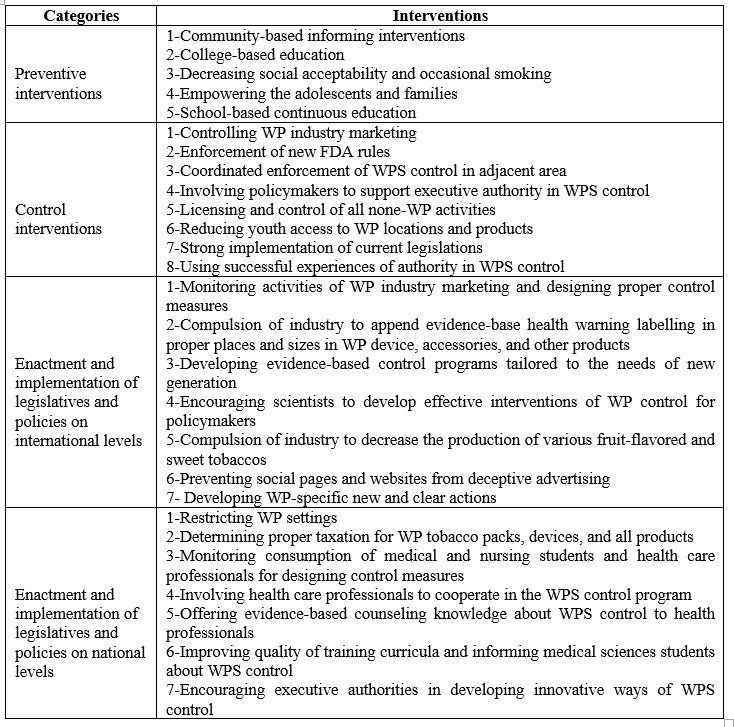
Water pipe smoking as a public health crisis
Water Pipe Smoking (WPS) accounts for a significant and growing share of tobacco use globally. WPS is a culture-based method of tobacco use and it has experienced a worldwide re-emergence since 1990 and is regaining popularity among different groups of populations, especially in school and university students. Similarly, WPS is also prevalent among highly educated groups. Although WPS is most prevalent in Asia, specifically the Middle East region and Africa, it has now been changed to a rapidly emerging problem in other continents such as Europe, North, and South America.
WP business has remained largely unregulated and uncontrolled, which may result in the increasing prevalence of WPS.
It has been shown that WPS’ smoking rate can be more addictive compared to that of the cigarette. It has a huge negative impact on populations’ health, health costs and the gross domestic product of the countries. WP business has remained largely unregulated and uncontrolled, which may result in the increasing prevalence of WPS. Using deceptive advertising, many cafes and restaurants offer WP services along with their orthodox services in order to earn more profit and lure more customers. The provision of flavored tobacco products or psychotropic WP, the proximity of WP cafe to the public settings such as educational or residential settings and sports clubs, tempting decoration, the provision of study places for students, live music, a variety of games and gambling, and the possibility of watching live movie and sport matches are the factors contribute to attracting children and adolescents to WP cafes.
The importance of our study
Despite the concerns about WPS outcomes and nearly three decades of using control measures, the prevalence of WPS has increased over the world. Due to the unique nature of WP (multi-components), little is known about the prevention and control of WPS. Thus, special interventions might be required to prevent and control WP tobacco use. Accordingly, our study published in BMC Public Health aimed to identify the management interventions in international and national levels for preventing and controlling water pipe smoking.
Our study
We conducted a systematic literature review. Studies aiming at evaluating, at least, one intervention in preventing and controlling WPS were included in this review, followed by performing the quality assessment and data extraction of eligible studies by two independent investigators.
After deleting duplications, 2228 out of 4343 retrieved records remained and 38 studies were selected as the main corpus of the present study. The selected studies focused on 19 different countries including the United States (13.15 %), the United Kingdom (7.89 %), Germany (5.26 %), Iran (5.26 %), Egypt (5.26%), Malaysia (2.63%), India (2.63%), Denmark (2.63%), Pakistan (2.63%), Qatar (2.63%), Jordan(2.63%), Lebanon (2.63%), Syria (2.63%), Turkey (2.63%), Bahrain (2.63%), Israel (2.63%), the United Arab Emirates (2.63%), Saudi Arabia (2.63%), and Switzerland (2.63%). Additionally, the type of study design included cross-sectional (31.57 %), quasi-experimental (15.78 %) and qualitative types (23.68 %).
Interventions that were identified from the content analysis process were discussed and classified into relevant categories. We identified 27 interventions that were grouped into four main categories including preventive (5,18.51%) and control (8, 29.62%) interventions, as well as the enactment and implementation of legislations and policies for controlling WPS at national (7, 25.92%) and international (7, 25.92%) levels. The interventions are shown in the following table.

Study implications
The current enforced legislations are old, unclear, incompatible with the needs of the adolescents and are not backed by rigorous evidence.
In general, our findings indicated WPS related social and health crisis have not come into attention in high levels of policy making. The current enforced legislations are old, unclear, incompatible with the needs of the adolescents and are not backed by rigorous evidence. In addition, the WP industry is rapidly expanding without monitoring and controlling measures. Informing and empowering adolescents for those who have not yet experienced smoking is a sensible intervention in this regard. Besides, empowering and involving health students and professionals in WPS control programs can lead to promising results in preventing and controlling WPS. It seems that there is a paucity of evidence regarding strategies on controlling and preventing WTS, thus further research in the society is warranted in this respect.
Comments